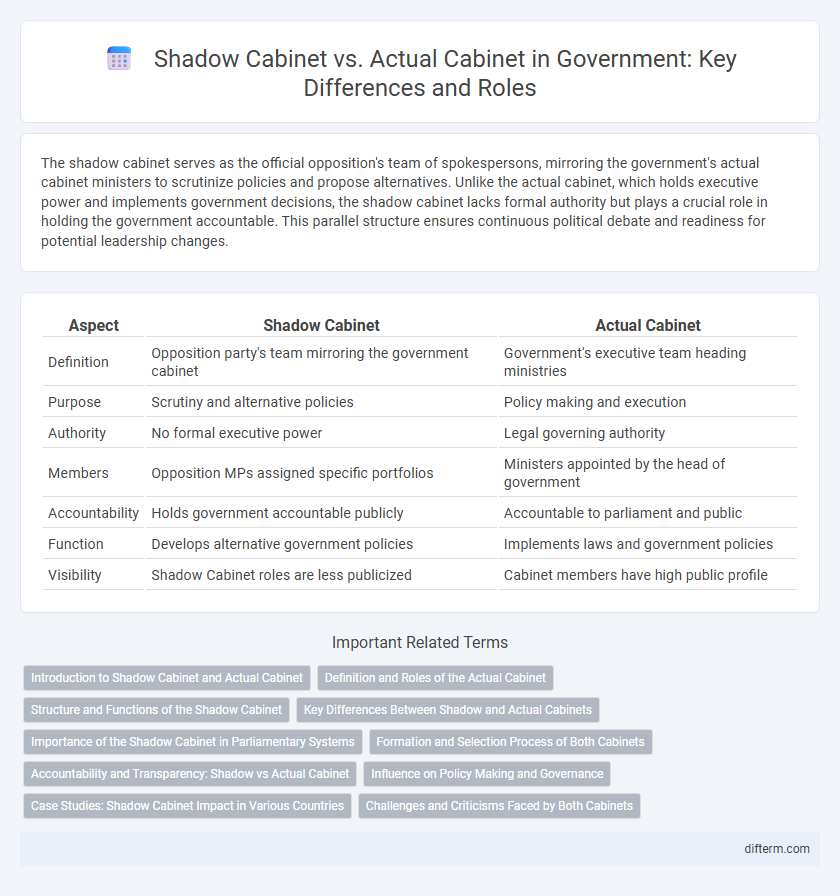The shadow cabinet serves as the official opposition's team of spokespersons, mirroring the government's actual cabinet ministers to scrutinize policies and propose alternatives. Unlike the actual cabinet, which holds executive power and implements government decisions, the shadow cabinet lacks formal authority but plays a crucial role in holding the government accountable. This parallel structure ensures continuous political debate and readiness for potential leadership changes.
Table of Comparison
| Aspect | Shadow Cabinet | Actual Cabinet |
|---|---|---|
| Definition | Opposition party's team mirroring the government cabinet | Government's executive team heading ministries |
| Purpose | Scrutiny and alternative policies | Policy making and execution |
| Authority | No formal executive power | Legal governing authority |
| Members | Opposition MPs assigned specific portfolios | Ministers appointed by the head of government |
| Accountability | Holds government accountable publicly | Accountable to parliament and public |
| Function | Develops alternative government policies | Implements laws and government policies |
| Visibility | Shadow Cabinet roles are less publicized | Cabinet members have high public profile |
Introduction to Shadow Cabinet and Actual Cabinet
The actual cabinet consists of senior government ministers responsible for executive decision-making and policy implementation, led by the prime minister or head of government. The shadow cabinet is formed by the opposition party, comprising members who scrutinize and challenge the policies of the actual cabinet while proposing alternative solutions. Both structures are crucial in parliamentary systems for maintaining democratic accountability and offering voters clear policy choices.
Definition and Roles of the Actual Cabinet
The actual cabinet consists of senior government ministers headed by the prime minister, responsible for formulating and implementing national policies and administration. These ministers oversee various government departments, making key decisions to manage public resources and deliver services. The cabinet functions as the central executive authority, ensuring coordinated governance and accountability within the government framework.
Structure and Functions of the Shadow Cabinet
The shadow cabinet mirrors the actual cabinet's structure to provide a clear alternative government, with designated members responsible for specific policy areas such as finance, defense, and education. Its primary function is to scrutinize government actions, propose alternative policies, and hold ministers accountable in parliamentary debates. This system ensures continuous political oversight and prepares opposition members for potential governance roles.
Key Differences Between Shadow and Actual Cabinets
The actual cabinet consists of senior government ministers responsible for executing laws and policies, while the shadow cabinet comprises opposition members who scrutinize and propose alternatives to government actions. Cabinet members hold formal executive power, manage ministries, and participate in decision-making processes, whereas shadow cabinet members hold no official authority but focus on holding the government accountable. The key difference lies in legitimacy and function: actual cabinets govern, shadow cabinets monitor and challenge.
Importance of the Shadow Cabinet in Parliamentary Systems
The shadow cabinet plays a crucial role in parliamentary systems by providing structured and informed opposition that holds the government accountable and scrutinizes its policies. Each shadow minister mirrors a government counterpart, ensuring expert critique and alternative policy proposals that enhance democratic debate and transparency. This system promotes effective governance by preparing opposition members for potential future leadership roles.
Formation and Selection Process of Both Cabinets
The actual cabinet is formed through formal procedures where the Prime Minister or President selects members from the ruling party or coalition based on political experience, expertise, and party loyalty. The shadow cabinet, in contrast, is composed by the opposition party to mirror the actual cabinet's key positions, aiming to scrutinize government policies and present alternative solutions. Selection for the shadow cabinet emphasizes parliamentary experience and readiness to assume official roles rather than formal appointment or constitutional endorsement.
Accountability and Transparency: Shadow vs Actual Cabinet
The actual cabinet holds formal executive power, responsible for implementing policies with accountability through parliamentary scrutiny, official reports, and public transparency mechanisms. The shadow cabinet, composed of opposition members, provides oversight by critically evaluating government actions and proposing alternatives but lacks direct decision-making authority, limiting its transparency to public debates and media engagement. Both structures contribute to democratic accountability, with the actual cabinet subjected to legal and institutional checks, while the shadow cabinet enhances political accountability by fostering transparency through opposition scrutiny.
Influence on Policy Making and Governance
Shadow cabinets hold significant influence on policy making by scrutinizing government actions and proposing alternative strategies, shaping public debate and political accountability. Actual cabinets possess direct authority to implement laws, manage state affairs, and execute government policies, crucially determining the direction of governance. The dynamic interaction between shadow and actual cabinets fosters a system of checks and balances, enhancing transparency and responsiveness in governmental decision-making.
Case Studies: Shadow Cabinet Impact in Various Countries
Shadow cabinets in countries such as the United Kingdom, Australia, and Canada play a critical role in parliamentary democracy by holding the government accountable and policy scrutiny. In the UK, the Labour Party's shadow cabinet famously influenced public debate and legislative proposals during periods of Conservative governance, demonstrating the power of structured opposition. Australian shadow cabinets have been pivotal in shaping policy alternatives, with case studies revealing their strategic impact on electoral outcomes and governance reforms.
Challenges and Criticisms Faced by Both Cabinets
Both the shadow cabinet and the actual cabinet face challenges related to accountability and public scrutiny, with the shadow cabinet often criticized for lacking formal authority and resources, while the actual cabinet confronts intense pressure to deliver effective governance and policy implementation. The shadow cabinet struggles to maintain relevance and influence without official power, whereas the actual cabinet is vulnerable to political opposition, media scrutiny, and public dissatisfaction over policy failures or scandals. Both are subject to criticisms regarding transparency, responsiveness, and the ability to represent diverse interests within the government framework.
shadow cabinet vs actual cabinet Infographic

 difterm.com
difterm.com